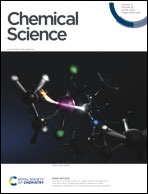Metastable doubly threaded [3]rotaxanes with a large macrocycle†
Abstract
Ring size is a critically important parameter in many interlocked molecules as it directly impacts many of the unique molecular motions that they exhibit. Reported herein are studies using one of the largest macrocycles reported to date to synthesize doubly threaded [3]rotaxanes. A large ditopic 46 atom macrocycle containing two 2,6-bis(N-alkyl-benzimidazolyl)pyridine ligands has been used to synthesize several metastable doubly threaded [3]rotaxanes in high yield (65–75% isolated) via metal templating. Macrocycle and linear thread components were synthesized and self-assembled upon addition of iron(II) ions to form the doubly threaded pseudo[3]rotaxanes that could be subsequently stoppered using azide–alkyne cycloaddition chemistry. Following demetallation with base, these doubly threaded [3]rotaxanes were fully characterized utilizing a variety of NMR spectroscopy, mass spectrometry, size-exclusion chromatography, and all-atom simulation techniques. Critical to the success of accessing a metastable [3]rotaxane with such a large macrocycle was the nature of the stopper group employed. By varying the size of the stopper group it was possible to access metastable [3]rotaxanes with stabilities in deuterated chloroform ranging from a half-life of <1 minute to ca. 6 months at room temperature potentially opening the door to interlocked materials with controllable degradation rates.
![Graphical abstract: Metastable doubly threaded [3]rotaxanes with a large macrocycle](/en/Image/Get?imageInfo.ImageType=GA&imageInfo.ImageIdentifier.ManuscriptID=D2SC01486F&imageInfo.ImageIdentifier.Year=2022)
- This article is part of the themed collection: Most popular 2022 supramolecular chemistry articles


 Please wait while we load your content...
Please wait while we load your content...